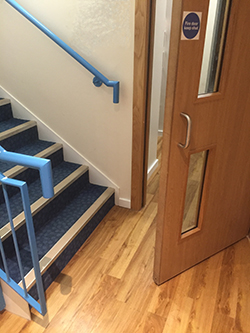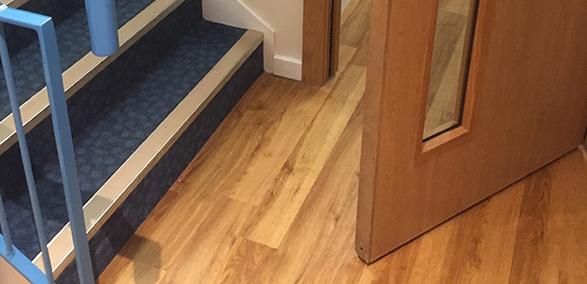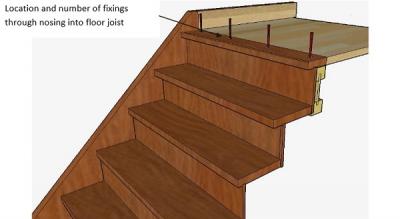How to get it right: Door swings
Article updated on 31 January 2024
 One of our surveyors recently sent in this photo, taken in a brand new commercial building.
One of our surveyors recently sent in this photo, taken in a brand new commercial building.
It’s the ground floor of a protected staircase and shows the door swing directly over the bottom of the stair within the landing space.
Clear space should be provided at the top and bottom of flights of stairs measuring at least the width of the stair and this can be reduced to 400mm at the bottom of stairs within dwellings.
This is to protect those on the staircase as there's a danger of being hit by the door swinging into them when they’re nearing the bottom of the steps or an injury caused by a fall.
The 400mm allowance for dwellings is because there is usually only one person on the stair so they could stop to steady themselves to ‘dodge’ the door swinging at them.
In buildings other than dwellings, and particularly within a protected stair, a door opening across the bottom of the stair will form a bottleneck for those escaping, and the potential to cause serious injury.
While the area around the door in the image above needed a replastering job and redecoration, the door and frame could be reversed to open away from the stairs and into the lobby instead, because the number of people moving from that area was less than 60.
Further information
Find out more and download Approved Document K.
Read more 'How to get it right' articles
Please Note: Every care was taken to ensure the information was correct at the time of publication. Any written guidance provided does not replace the user’s professional judgement. It is the responsibility of the dutyholder or person carrying out the work to ensure compliance with relevant building regulations or applicable technical standards.
Sign up to the building bulletin newsletter
Over 48,000 construction professionals have already signed up for the LABC Building Bulletin.
Join them and receive useful tips, practical technical information and industry news by email once every 6 weeks.
Subscribe to the Building Bulletin




Comments
fire pocket door before or after single step down into room
Submitted 5 years 4 months ago
Cheers!
Reply
Submitted 5 years 3 months ago
It may well be possible to have a fire rated pocket sliding door at the base of the existing staircase, however it isn't considered appropriate to give specific advice based on the details provided.
You should contact your local authority building control team to discuss this matter further. (Enter your postcode into the search box on the righthand side at the top of this page for contact details.)
I trust you find this response of some use.
Kind regards
Richard, LABC
Door into Garage conversion
Submitted 5 years 3 months ago
Reply
Submitted 5 years 3 months ago
The work you describe doesn't appear to satisfy the requirements of the building regulations I'm afraid. We would advise you to employ a competent designer to advise you further.
Kind regards
Barry, LABC
Bottom step proximity to door
Submitted 4 years 8 months ago
Just had a survey done on a house and something has come up with the loft conversion. Our surveyor has said that because the door is adjacent to the bottom step it’s unlikely to meet building regs. However, the door opens inwards. As it opens in and doesn’t swing across the landing, is this ok? Have asked for correct docs but yet to hear.
Thanks.
Door onto landing at the top of domestic stairs
Submitted 4 years 8 months ago
Thanks!
Dwelling
Submitted 4 years 1 month ago
Does 400mm rule can be applied to block of flats?
Part K is not clear on that. Sometimes provisions are labelled as 'dwelling' 'building other than dwellings' 'common access areas in buildings that contain flats'.
Paragraph 1.24 is not clear whether it applies to block of flats.
Kind regards,
Katarzyna Jarzebowska
LABC response
Submitted 4 years 1 month ago
The definition of a dwelling is given in Reg 2(1) – ‘dwelling’ includes a dwelling-house and a flat.
The meaning of a flat is – separate and self-contained premises constructed or adapted for use for residential purposes and forming part of a building from some other part of which it is divided horizontally.
So, a flat can be dwelling, but only in relation to the compartment in which the flat (the dwelling) is contained. It does not appear to me to extend to the whole block, by virtue of the words: ‘separate and self-contained….and forming a part of a building from some other part…’. Consequently, I would say that the meaning of a dwelling is restricted to that of a house and a flat – but not the common parts of a block of flats.
Applying the above to AD K, and para 1.24/diag 1.8 in particular, this can only be a condition that can occur to a dwelling (including a flat) and not to the common parts of a block of flats. As such it is my interpretation that the 400mm rule cannot be applied to any of the common parts of the building that forms a block of flats.
If we go back to para 1.23, which deals with landings in buildings other than dwellings – which by association we can apply to the common parts of an apartment block – then the guidance at para 1.23c says – ‘Provide…. Doors that do not swing across landings, except where they comply with paragraph 1.21c.’
So, initially it seems that doors in the common parts of a block of flats cannot have doors opening over a landing at all. However, para 1.21c, goes on to say –
For all buildings – again we can include the common parts of an apartment block and any part of a dwelling (incl a flat) as being covered by para 1.21 onwards – ‘A landing… may have doors to cupboards and ducts that open over a landing at the top of a flight, as shown in Diagram 1.7, but only when they are kept shut or locked shut when under normal use.’
As a result, I would say that the 400mm rule, given in para 1.24 and diag 1.8 of ADK, does not apply to the bottom landing of any flight of stairs in the common part(s) of a block of flats, as these areas are not classed as a dwelling (either a dwelling-house or a flat). However, by virtue of paras 1.23b and 1,21c/diag 1.7 doors to a cupboard or service duct/riser shaft, that are normally kept shut or locked, can open over the top landing of a flight, so long as there is at least 400mm between the nosing of the topmost riser of a flight and the leading edge of any open cupboard door.
Best,
LABC team
(No subject)
Submitted 4 years ago
That was exactly my thinking when reading Part K.
Thank you very much for the detailed response and the confirmation.
Kind regards,
Katarzyna Jarzebowska
Dwelling door opening inwards by stair landing
Submitted 3 years 3 months ago
Ychwanegu sylw newydd